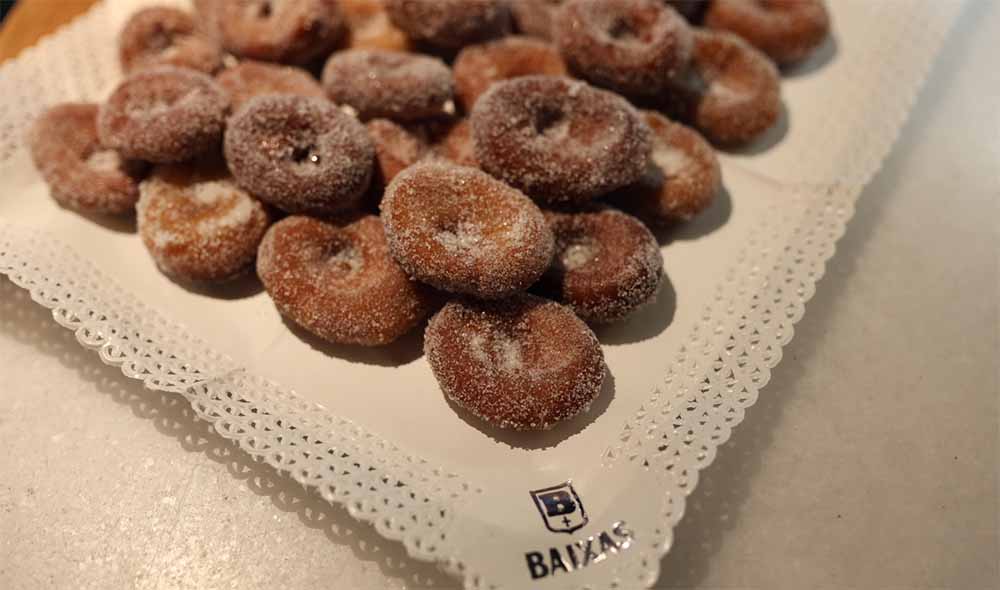The process of making the Recepta De Bunyols De L’empordà will make them reappear in life. These fried dough delights, soft in the middle and crispy on the outside, have been pleasing generations. They are especially popular during Holy Week, but locals consume them year-round. There are Catalan grandmothers who are still making them in village kitchens, passing secrets by whisper and flour-dusted finger.
But in contrast to commercial doughnuts, there’s history and sentiment attached to these bunyols. Sweetened with anise and lemon zest, the dough, like the Empordà countryside, has a rough-hewn beauty. Each bite murmurs Spanish countryside mornings and cozy kitchen powwows. People love them for more than just flavour, because what they really love is what they represent – family, memory, identity.
To whip up this Recepta de Bunyols de L’empordà is to do more than bake; it is to resurrect tradition. We are celebrating our own cultural heritage by making these at home. It’s also an invitation to slow down, make by hand and fry with love. No matter if you’re an amateur cook or a pro baker, making these cakes is a residents’ seminar on Catalan roots. Even just the smell of it is enough to warm your heart, make you happy, and brings a bit of nostalgia with every batch.

The Origins of Recepta De Bunyols De L’empordà in the Empordà Region
The Recepta de Bunyols de L’empordà is centuries old and poignantly captures the essence of the rural life from northeastern Catalonia. In the Empordà, families made these during Lent and Easter, rallying generations in the kitchen to form the iconic rings. The recipe varied just a bit as it spread from household to household, while never changing too much from its original identity.
Surrounded by the Pyrenees and the Mediterranean, Empordà boasts fertile land and bountiful agriculture. Recipes too, reflect this plentiness, and bunyols are a testimony. The dough is made with local ingredients like farm eggs, fresh milk and wild lemon zest, all produced in surrounding fields or picked up at village markets. This sense of season and place is exactly what makes these treats so genuine.
Simple and fragile, the Recepta de Bunyols de L’empordà is a recipe from the heart, and for that reason, it’s still alive and well. Every family added its own small touch — some liked more anise, while others allowed the dough to rise longer to make a more pillowy cookie. Whatever the case, they connected people over small, round bites. They’re more than just pastries; they’re edible heirlooms in the tapestry of Catalonian cuisine.
Ingredients That Bring the Tradition to Life
To make the Recepta de Bunyols de L’empordà, families will find that all the ingredients are basic, yet vital to the Empordà culinary experience. Flour, eggs, sugar, milk, yeast form the base together. But what makes the bunyols is an aromatic twist — lemon zest and aniseed liqueur lend fragrance and flavor that stays around.
Each of these parts may look unassuming, but all serve essential functions. The yeast action provides a bit of lift in the dough, which becomes the airy crumb of bunyols. Eggs add richness but sugar is barely missed in every bite. Zest brightens, and an aniseed liqueur deepens. They come together to create a perfectly balanced and unforgettable dough.
What’s special about this Recepta de Bunyols de L’empordà is not just what’s in it, but how you bring all that together. It ages and ferments, and the dough absorbs the aromas. And when fried, they puff up nicely. The outside gets crisp while the inside is still tender and warm. It’s a bit of magic wrought from simplicity and attention.
Preparing the Dough with Patience and Care
Making the dough for a Recepta de Bunyols de L’empordà is more than a process—it’s the path to intuition and love. Begin by warming up the milk (just slightly) and dissolve the fresh yeast until it bubbles a bit. Gradually blend in flour, sugar, eggs, aniseed, and zest. Stir continuously until you get soft elastic dough.
When kneaded, give the dough time to mellow and relax in a warm, covered bowl. They are important for the fermentation process. During the resting, the yeast does its thing, releasing air that’s ultimately responsible for the tendency of the bunyols to puff. Depending on how warm your kitchen is, it could take an hour or longer. Patience here pays off.
D The Recepta de Bunyols de L’empordà really springs to life here. As the dough doubles in size, you will observe its softening texture and its sweet, citrusy fragrance. Lightly flour your hands, and when you are ready, shape the dough into small loops. All of them may look different, but the fact that they are less than perfect is part of the point. They are roughhewn, home-baked, filled with heart.
Frying Techniques for Golden Perfection
The frying in the Recepta de Bunyols de L’empordà turns plain dough into golden orbs of perfection. Then in a deep, heavy pan put the sunflower oil on to heat at a steady medium. Lower the rings into the hot oil carefully and see how they float up and sizzle.
Fry in batches so that the oil stays hot. Every bunyol will puff and float, browning on the outside. Turn them with a slotted spoon frequently so that they cook evenly, and are lightly browned all over. Its surface should be sharp, not greasy, with a glistening gold facade that tempts your first bite.
Once done, put them on kitchen paper to get rid of the extra oil. Sprinkle with granulated sugar while they are still warm. This last bit gives a welcomed crunch. And the creme de la creme of my childhood: the Recepta de Bunyols de L’empordà, whose success depends on the proper fry—crispy on the outside, soft on the inside with sugar that glows under sunlight. A bunyol, hot from the oil, is a victory for homemade pleasure new to me.
Serving Suggestions to Enhance the Experience
When not served as an appetizer, Recepta de Bunyols de L’empordà is traditionally offered warm with a dusting of sugar and conversation. These delightful pastries can be enjoyed morning (with coffee), afternoon (with tea), or evening (with wine). Nandos are just so versatile and are loved the length and breadth of Catalonia.
Traditional as it is, bunyols will taste even better if you enjoy them with some local products. A little drizzle of honey or a side of jam sweetens the dish. Serve with muscatel wine or a light herbal tea that will offset the aniseed scent. You can also re-warm them a bit before serving to bring it all back to temperature and texture.
What makes the Recepta de Bunyols de L’empordà so successful is that it meshes with social moments with the greatest of ease. Served at family reunions, town festivals or slow weekends, these pastries are all about community. They’re more than a mere food; they’re a vehicle of joy, celebration and comfort for multiple generations.
Seasonal Celebrations and Recepta De Bunyols De L’empordà Traditions
The Recepta de Bunyols de L’empordà is an important part of the Catalan round-up of seasonal celebrations, including Lent and Easter. Every spring, bakeries and houses hum in anticipation. Bunyols are all about renewal, warmth and togetherness. Preparing them is a ritual associated with both religion and cultural history.
In Empordà villages, it’s not unusual to find whole families getting involved in the production of bunyols over the Holy Week. Grandparents teach children — techniques and stories. Town squares might feature bunyol fairs with locals peddling their creations, and friendly contests decide whose is the fluffiest or most flavorful batch.
Tied to the calendar though they may be, buns filled with crema are not just the taste of spring. It is a year-round comfort food that people long for, and cry out for around family tables and community tables. These pastries change with the availability of joy or memory, continuing to tell us how food and tradition are deeply connected.
Healthier Versions Without Compromising Flavor
And for something lighter, the Recepta de Bunyols de L’empordà can easily be modified to fit the dietary habits of today without losing its original character. If you don’t, try baking in place of deep-frying. While the texture changes just a bit, you still can get a satisfying outer crisp in a convection oven with high heat.
Other fill-ins work great, too. Substitute white flour for whole wheat or spelt for an extra dose of fiber. Replace refined sugar with coconut sugar or honey for a less sweet flavor. If you’re not drinking, you can substitute aniseed liqueur with fennel seed infusion or anise extract. Any substitution still satisfies my tastes for all three meals.
Play around with the Recepta de Bunyols de L’empordà in a creative but respectful way and keep its roots. By tweaking techniques and tweaking ingredients, you can keep the tradition alive and more manageable. It’s these mini adjustments which ensures everyone gets to enjoy a bunyol, while still respecting the long legacy this delicious little treat carries with every bite.
Keeping the Tradition Alive for Future Generations
Passing on the Recepta de Bunyols de L’empordà to the next generation, ensures the recipe never becomes a memory. Allow children to knead the dough, smell the anise and watch the dough rise. Baking becomes storytelling through hands-on learning, culture carried through flour and fire.
Family recipes such as this one thrive when they are written down, shared and practiced. Think of making bunyols as a festival or holiday tradition. Invite neighbors, hold workshops, even document the process your own family follows. In a world that’s moving rapidly toward convenience and industrial production, those practices help to sustain culinary identity.
The Recepta de Bunyols de L’empordà is also through the past to the present. Learning its steps is more than lessons in food — it’s lessons in identity, love and belonging. It links generations through something palpable and delightful, making history present in everyday life.
Conclusion: Why Recepta De Bunyols De L’empordà Matters
The Recepta de Bunyols de L’empordà goes beyond taste: it embodies the very soul of Catalan tradition in a sweet, round shape. To make it is to bind people across time and space, connecting today’s kitchens to centuries of farm life and thwarted care. It’s visceral and cultural at the same time.
Amid the hustle and bustle of our busy lives recipe like this are an invitation to slow down. They present cheer in the mundane, beauty in the banality. From the mixing to the frying, every step brings us back to the present, and, at the end, the final product brings us back to the past. Each bunyol is more than a morsel, it’s a narrative.
By making and sharing the Recepta de Bunyols de L’empordà, we keep history alive. We feed tail and soul, honour tradition, and remind ourselves of the power of homemade food. These demure pastries, meanwhile, remain little golden tokens of memory, communion, love — flavored with anise, shaped over time.







